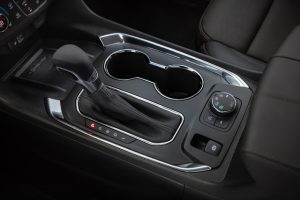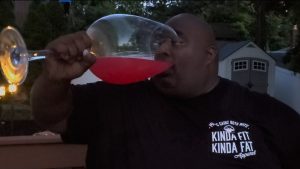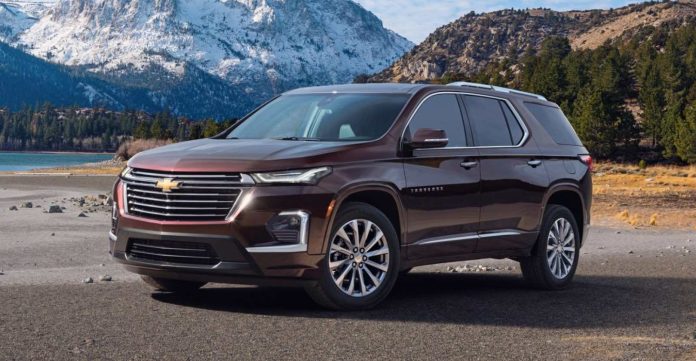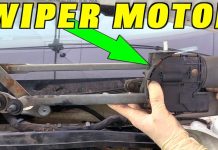There’s something disconnecty about a two-ton SUV powered by a 2.0 liter four cylinder engine.
In fact, there are only a few two-ton SUVs that still come standard with a V6 engine. One of them being the Chevy Traverse.
What It Is
The Traverse is Chevy’s medium-sized/three-row SUV, one size down from the Tahoe.
Technically, the Traverse is a crossover SUV because it is built on a lighter-duty, car-type chassis and comes in either front-wheel-drive or (optionally) all-wheel-drive versions. The Tahoe – which is an SUV – is built on a heavier-duty, truck-type platform and is rear-wheel-drive, with four-wheel-drive (and Low range gearing) available. It also comes standard with a V8 – which it needs, because it weighs close to three tons.
Prices for the Traverse start at $34,200 for the base LS trim with front-wheel-drive; AWD can be added as a stand alone option, bringing the MSRP up to $36,220.
A top-of-the-line High Country with AWD, a power-folding third row seat, heavy-duty cooling and towing enhancements (including hitch guidance through the touchscreen) lists for $53,900.
All trims comes standard with a 3.6 liter V6 engine paired with a nine speed automatic transmission.
What’s New for 2023
LT and higher trims now come standard with a leather-wrapped steering wheel and gear selector handle.
The current Traverse dates back to 2018, the last time it was significantly updated.
What’s Good
V6 is standard in all trims.
Most total cargo capacity in its class (98.2 cubic feet).
What’s Not So Good
Base trim only tows 2,000 lbs.
V6 uses almost as much gas as a V8.
Driver “assistance” systems can be pushy and parenting.
Every Traverse comes standard with the same 3.6 liter V6, which makes 310 horsepower and 266 ft.-lbs. of torque, paired with a nine speed automatic transmission.
The four cylinder engines that are becoming commonly standard in even two-ton crossover SUVs (e.g., the VW Atlas, Mazda CX9) can conjure comparable horsepower and – usually – more torque, because they are turbocharged.
The downside – at least possibly – is that they are turbocharged.
Turbos create additional heat as well as pressure. These can be compensated for by upgrading the cooling (including oiling) system to dissipate the heat – and by using high-strength internal parts that can handle the additional pressure. But there will always be the additional parts – the turbo, intercooler, etc. – and so more parts that could eventually fail.
With a V6 (one that’s not turbocharged) you won’t have to worry about that. And a bigger engine that doesn’t need a turbo to make up for being otherwise too-small (and not powerful enough) for the vehicle it’s tasked with moving is under less . . . pressure and so is likely to last longer. Especially if “longer” means 12-15 years or longer, which may matter to you if you plan on keeping your vehicle that long.
Or longer.
On the downside, the V6 uses nearly as much gas a V8.
EPA says the Traverse will travel 18 miles on a gallon in the city and 27 on the highway. The V8-powered Chevy Tahoe – which is a truck-based SUV that weighs 1,200 pounds more than the Traverse – rates 15 city (just three miles less than the Traverse) and 20 on the highway.
The overall difference being about 5 MPG.
Part of the reason for this being that the Traverse weighs 4,310 lbs. – before anyone gets in. With just two average-sized people in board, this crossover SUV will weigh as much as V8 SUVs used to (the new ones weigh even more).
On the other hand, the four-cylinder version of the also-two-ton-plus VW Atlas only manages 21 city, 25 highway. The Mazda CX-9? Only 20 city, 26 highway.
And you can pull up to 5,000 lbs. with the Traverse – which is more than the typical 3,500 lbs. or so that most light-duty, mid-sized crossovers are typically rated to handle. However, this isn’t the Chevy’s standard tow rating – unlike the standard 5,000 lb. tow rating of the Chevy’s most direct rival, the very impressive Kia Telluride – which also comes standard with a V6 and costs less to start.
The Chevy’s standard max tow rating is only 2,000 lbs. – which isn’t much more than most compact-sized crossovers can handle.
To get the 5,000 lbs. tow-capability, you have to buy at least the LT trim and then buy the V92 trailer towing package, which adds the heavy-duty cooling system and other upgrades necessary to be able to pull 5,000 lbs. without overheating – or breaking. But this boosts the Chevy’s price to $36,745 – before paying another roughly $400 extra for the V92 package.
The Telluride can pull 5,000 lbs. – for $33,390 (the MSRP of the base trim).
On The Road
There’s not much to write home about here – and in a way, that’s good.
Just boring.
After 120-plus years of continuous development, cars – and trucks and crossovers and crossover SUV and SUVs, etc. – are what they call a “mature technology.” The improvements are more incremental now than dramatic. Engines – like the V6 in this Traverse – make what would have been considered “super car” power as recently as the early ’90s – when you had to buy something like a Corvette to get 300-plus horsepower – and they do it six cylinders and without turbos and absolutely no drama, at all.
Open the door, sit down – and go.
The main thing you get here – vs. the turbo fours that are rapidly replacing V6s – is the deeper sound made by the V6, which sounds right with a vehicle of this type. The fours make impressive power, many of them – and their low-RPM torque production is greater and they seem to move the vehicle easier with less throttle. But they just don’t sound right. It’s why many of them have augmented sound. Meaning, more substantive sounds are piped into the passenger cabin through the audio system, to make the four sound like something more.
The Chevy’s V6 doesn’t need augmentation – and that’s a standard feature.
Some who’ve reviewed this Chevy complain about not-so-great to-the-side (and rearview) visibility, due to thick side pillars and not enough glass area. It’s a valid criticism – but one that applies generally, to pretty much all new vehicles. The reason why has to do with a trade-off. Visibility is sacrificed for the sake of crashworthiness. That is to say, to perform better in crash tests. This requires more steel and less glass. Of course, a crash would probably be less likely if visibility to the side and rear were better.
My chief complaint is the intrusiveness of the embedded “assistance’ technology – which means things like Lane Keep Assist and Automatic Emergency Braking. These intrude often and often when not necessary. Painted lines on the road aren’t always painted accurately. If the Traverse touches one the Lane Keep Assistance thinks you need “assistance” and pulls the wheel in one or the other direction. Similarly, the thing will brake if you don’t – because it thinks the vehicle 20 yards ahead of you that’s turning off the road is still going to be there when you get there.
The good news is you can turn most of this stuff off. The bad news is you can’t just skip it altogether as GM – like pretty much every automaker – has made this stuff standard in pretty much everything it sells.
The Traverse come standard with three rows, so it seats up to eight people – two of them probably kids. They are the ones who’ll be riding in the third row, which isn’t sized for adults or easy to access for adults. But the same is true of other mid-sized crossovers with third rows. If you need a third row that is adult-friendly, you will probably want to move up a size to something full-sized (like the Tahoe).
What the Traverse does have is a lot of is room for cargo. More than any other model in this class, in fact.
A total of 98.2 cubic feet, which is significantly more than the Telluride’s 87 cubic feet. Having all this room (and versatility) is among the chief virtues of these crossovers – especially relative to truck-based SUVs, which often have less than you’d expect because of their truck-sourced underpinnings, which eat up floor space.
The Traverse also still has analog gauges in the instrument cluster.
This bucks the trend – which began at the high-end of the market – of replacing dials and needles with LCD screens. The latter are often “configurable,” meaning you can toggle through a variety of different displays. But they are also becoming so common that having gauges and needles is becoming as distinctive as having flat-screen displays was just a few years ago. And while LCD screens do look slick right now, they are apt to look dated a few years from now – just like the smartphone you have today probably will by then. Needles and dials hold up better, visually and quite possibly, functionally.
Surprisingly, heated seats aren’t standard – you have to buy the LT (or higher) trim to get them. This reflects the age of the current Traverse, which dates back to 2018. Five years ago, heated seats were still a near-luxury item and often optional. Today, they are standard in almost everything that’s come out within the past two years or so, including a number of vehicles that cost a lot less than the $35k-plus it takes to get into a Traverse LT with heated seats.
An interesting thing you do get is a hidey-hole behind the secondary LCD screen at the top of the center stack. It’s a great place to hide a wallet or some other thing you don’t want seen and this feature is unique to GM vehicles that have this set-up.
The sport-themed RS gets a 20 inch wheel/tire package but is otherwise mechanically identical to other Traverse trims.
Interestingly, this version of the Traverse used to come standard with a . . . 2.0 liter four cylinder engine. Which Chevy dropped because it belly flopped.
The Rest
Another interesting thing about the Traverse is that it comes with either of two different sized gas tanks, depending on whether you get the FWD model – in which case yours will have a 19.8 gallon tank – or the AWD model, which has a larger 21.7 gallon tank. Both tanks are large for the class – with 18 or so gallon tanks being typical. Having that extra gallon (or two) is nice because it means being able to drive an extra 20 or so miles before you’re running on fumes.
The Bottom Line
There are newer – and nicer models in this class, like the Kia Telluride (and its Hyundai Palisade cousin) that also offer a standard V6 – and more standard towing capacity. But you may have to pay more for them, for just that reason. Odds are you’ll be able to swing a better deal on this aging-gracefully Chevy – and if you do, you’ll end up with more room inside than others in the class, no matter how much you didn’t pay for them.
. . .
Got a question about cars, Libertarian politics – or anything else? Click on the “ask Eric” link and send ’em in! Or email me at EPeters952@yahoo.com if the @!** “ask Eric” button doesn’t work!
If you like what you’ve found here please consider supporting EPautos.
We depend on you to keep the wheels turning!
Our donate button is here.
If you prefer not to use PayPal, our mailing address is:
EPautos
721 Hummingbird Lane SE
Copper Hill, VA 24079
PS: Get an EPautos magnet or sticker or coaster in return for a $20 or more one-time donation or a $10 or more monthly recurring donation. (Please be sure to tell us you want a magnet or sticker or coaster – and also, provide an address, so we know where to mail the thing!)
My eBook about car buying (new and used) is also available for your favorite price – free! Click here. If that fails, email me at EPeters952@yahoo.com and I will send you a copy directly!















It’s ugly.
Hi Robert,
I’d say – homogenous. This is an issue with nine out of ten new vehicles.
Via Wordnik: “homogenous – Having the same origin; derived from the same source…”
No doubt!
Imho, machines can’t be ugly.
Lack of creativity, might be, tho.
‘the Traverse weighs 4,310 lbs. – before anyone gets in.’ — eric
An analogue to the human Body Mass Index — weight divided by the square of height — is easily defined for vehicles: weight divided by the square of wheelbase.
Automotive Mass Indexes have risen into the obesity zone. Far from fighting this plague, government fuels it.
I like my vehicles svelte: preferably under 3,000 lbs. Over 4,000 lbs is a hard no, no matter how shapely or well endowed.
Hi Jim,
Yup. An interesting point of reference is an old car like my ’76 Trans Am. It has an immense cast iron V8, a bolt-on steel front subframe. Stamped steel control arms and steel leaf springs. A solid cast iron rear axle and leaf springs. The hood is a massive slab of . . steel and very heavy. Yet the thing weighs hundreds of pounds less than this modern vehicle with wafer-thin exterior panels, some of them plastic, that has an entirely aluminum V6 that weighs half as much and a unibody….
The oil change on the V6 Colorado 4WD sucks! Because of where they put that PIA cartridge filter. No way to access it from anywhere else but above. Getting it off isn’t too bad. Getting the new one back through the “jungle” of the harness and lines…….better be flexible! I wouldn’t trust anyone but myself to do it correctly. I use Mobil 1 in it just to prolong the agony of it all!
Hi Rob,
Yup. There are usually “hacks” – as the kids style it – around these problems. I often will fabricate a tool to make getting a filter that’s hard to reach (by hand) off (and back on). Part of the fun, eh?
Always! Especially when it comes to old motorcycles! lol
“ I wouldn’t trust anyone but myself to do it correctly “
A wise man indeed – buddy’s wife took the Hyundai in for an oil change, trying to be helpful since he was working massive overtime. The quick change oil place was a bit too quick, didn’t install the filter cartridge correctly and she ran it out of oil on the way home. Claimed she never saw the oil light. John gets home, won’t turn over. Oil change place tried to deny it, he’s a lawyer that didn’t take long to resolve in his favor with a replacement engine for north of $6k installed.
I still do all my oil changes, sometimes rather someone else do it but nope, I trust me to take the time and get it right. Right includes a good quality filter and the correct oil.
You and I are cut from the same cloth. Quick usually means “done incorrectly” in my book. A friend of mine got his quick oil change and tire rotation at a dealer for his newish Ram truck. So quick they forgot to put the lug nuts on the right rear wheel. He found out about a quarter mile after pulling out. Horrible!
So the verdict is: buy the Telluride instead?
I follow a guy called the Car Wizard on YouTube and he rails against those 3.6L GM V-6’es. I thought they were good engines, and was looking at the Colorado with one. Your take?
Looks like early versions had timing chain/tensioner issues, internal fixes since then. It’s usually lack of oil maintenance that brings on engine problems. Also using the wrong coolant.
Traverse in 2021 still had a spin on filter, a bit awkward access from above, but should be able to pre fill the new filter half way it mounts sideways. I kept a 301 Pontiac V8 alive for 355k miles when most were dead before 100k – use the factory spec oil including weight and pre fill the filter when possible.
PS: The Colorado oil change video shows a cartridge filter not spin on, easy oil and filter change but no filter pre fill on that setup.
Hi Sparkey!
Ah, the Pontiac 301… much maligned back in the day. I got to interview some people within GM (at the time) and the plan had been that the 301 would be Pontiac’s “new” V8 into the ’80s (hence the off-center turbo hood bulge on the ’82-up Trans-Am). Imagine what might have been, had the 301 been the recipient of PFI and a proper turbo….
I learned to love that engine! Not a great oiler, the teeny oil filter didn’t help. I was shocked when I saw it, same location as my 1970 Firebird’s 350 filter but about half the size to clear the exhaust. My buddy at work, a Perdue engineering grad, explained why the mfg. oil specs were critical. 10W30 NO 10W40!
Even in its twilight years that motor would idle dead smooth, passengers “did your engine quit?” Nope, just a well balanced American V8.
Lots of engines with gummed rings and wiped cams from using the wrong oil back in the 80s. Backed up by my neighbor, the GM mechanic. Bright kid, he got oil burning warranty core motors for cheap, poured solvents (Rislone?) down the cylinders to free up the rings, put in the proper weight oil, Shazam! Motor like new!
Hi Tom,
GM has made a gadzillion of these 3.6 engines and they seem to be reliable and strong. The key thing – as is generally true – being maintenance, especially oil changes…
When they install adult seats not kiddie sized seats, might have a sale here. Still see they’ve got those #@$& seams in the middle of all the seat bolsters. Those seams may looks stylish but as they eat into you after about 40 minutes you’ll be a squirmin’ for certain.
Any proposed new car, rent that for a week then decide.